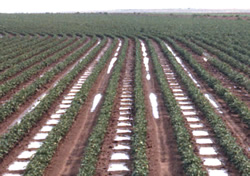This page has been archived and is being provided for reference purposes only. The page is no longer being updated, and therefore, links on the page may be invalid.
|
|
|
|
It Pays to Furrow Dike
By Dennis O'BrienJune 4, 2009
Furrow diking not only saves water, but reduces irrigation costs to a point where it makes economic sense, according to Agricultural Research Service (ARS) scientists.
Furrow diking is a tillage system where soils are plowed into ridge-like barriers running alongside row crops. The ridges hold irrigation and rain water, allowing it to soak into the soil instead of washing away.
Agronomist Russell Nuti at the ARS National Peanut Research Laboratory in Dawson, Ga., is exploring the use of furrow diking in the Southeastern United States, where runoff is a problem and water is a valued commodity. Farmers in the Southeast must irrigate to supplement rainfall, but reducing runoff would reduce the need for irrigation.
Nuti and Clint Truman, a soil scientist at the ARS Southeast Watershed Research Laboratory in Tifton, Ga., took two approaches to assess the effects of furrow diking on water needs and crop yields.
In one study, they compared the effects on runoff and erosion in cotton fields with and without furrow diking. They used a rain simulator, which replicates rainfall amounts from past storms, and moisture meters that automatically determine the soil's water needs.
They found that furrow diking during a moderate drought saved farmers an inch of irrigation water per acre, reduced runoff by 28 percent and curbed soil erosion. The next year, when drought conditions were more severe, it saved five inches of irrigation water per acre.
In a second study they compared crop yields, water needs and the effects of different irrigation rates on tracts of furrow-diked cotton with traditionally tilled cotton. There, they found that in one of three years, growers could reduce the irrigation rate by one-third and still achieve the same yield as a traditional cropping system. The difference in yields in this drought year was sufficient to pay for the practice of furrow diking for 12 years, according to Nuti.
The findings are being published in Agricultural Water Management.
ARS is the principal intramural scientific research agency of the U.S. Department of Agriculture.

